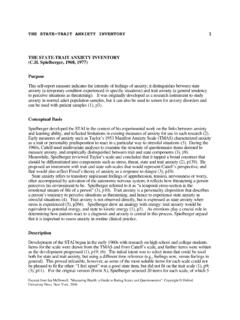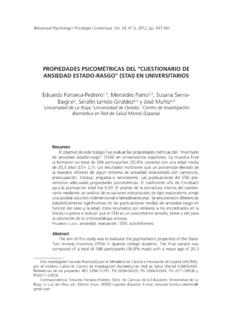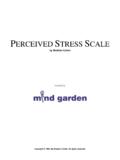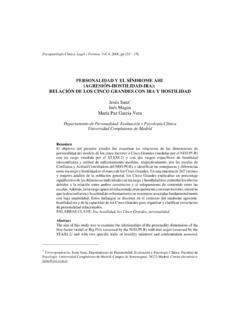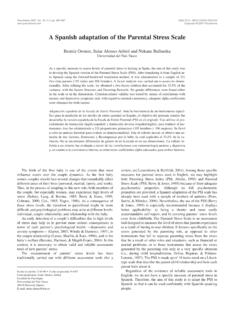Transcription of State-Trait Anger Expression Inventory™ Interpretive ...
1 State-Trait Anger Expression Inventory . Interpretive Report (STAXI-2: IR ). by Peter R. Vagg, PhD, and Charles D. Spielberger, PhD. Client Information Name: Sample Client ID#: 123-45-6789. Test Date: 07/12/2000. Test Description: intake evaluation Birthdate: 07/20/1973. Age: 26. Gender: Female Education: 16 years Occupation: Teacher Marital Status: Married Comments This is the comments area for the test protocol. PAR Psychological Assessment Resources, Inc. 16204 North Florida Ave. Lutz, FL 33549 Copyright 1979, 1986, 1988, 1989, 1991, 1996, 1999 by Psychological Assessment Resources, Inc. All rights reserved. May not be reproduced in whole or in part in any form or by any means without written permission of Psychological Assessment Resources, Inc. Version: ( ). Client: Sample Client Test Date: 07/12/2000. Client ID: 123-45-6789 Page 2 of 12. Interpretive Caveats The STAXI-2 was developed and standardized for use by psychologists and qualified professionals with adolescents and adults ages 16 years and older in a wide variety of settings.
2 The STAXI-2 has been normed separately for males and females in three age groups, permitting greater Interpretive specificity than many comparable self-report instruments. The STAXI-2 may be administered by trained staff, but interpretation of the results, including those presented in this report, should only be undertaken by a professional trained in psychological testing, or who has completed certified training concerning the use of STAXI-2. Such training should include information on emotional states and personality traits , and their relation to health and behavior. Professionals trained in the use of the STAXI-2 are best able to interpret the results validly and appropriately. This report is intended for use by qualified professionals. The Interpretive statements should be considered only one source of information about the respondent, and should be verified wherever possible by additional testing or information from the respondent. Professionals who interpret the STAXI-2:IR need to be aware that the language used in generating hypotheses may be misunderstood by a respondent who does not share the professional's experience and perspective.
3 For this reason, the report should not be given to the respondent, and feedback based on the Interpretive report should be provided in ways that can easily be understood. Note that the STAXI-2 contains no validity scales. Therefore, if faking, malingering or other response biases are suspected, further testing is recommended to evaluate these possibilities. Overview of the Report This Interpretive report is divided into the following three sections: Section I provides statements on protocol validity, a score summary table for the STAXI-2. scales and subsales, each with equivalent percentiles, T scores, and designated score levels ( , low, moderate, high, or very high), an item response summary table, and a STAXI-2 profile based on percentiles. Section II presents general Interpretive information for each of the respondent's STAXI-2 scale and subscale scores. In addition, important scale and subscale interactions provide further information about the respondent. Section III provides an overview of possible increased health or medical risks faced by the respondent as a result of her STAXI-2 scores.
4 Client: Sample Client Test Date: 07/12/2000. Client ID: 123-45-6789 Page 3 of 12. Section I. This Score Summary Table presents the raw scores, percentiles, T scores, and score levels (low, moderate, high, very high) for each valid STAXI-2 scale and subscale. The percentile results are shown graphically on a following page; the raw scores for each of the 57 items are reported in the Item Response Summary Table. STAXI-2 Score Summary Table Scale/subscale Raw score Percentile T score Score level State Anger S-Ang 22 85 58 high S-Ang/F 7 60 48 low-moderate S-Ang/V 10 90 66 high S-Ang/P 5 50 40 low-moderate Trait Anger T-Ang 19 65 52 moderate T-Ang/T 5 30 42 moderate T-Ang/R 11 80 56 high Anger Expression and Anger Control AX-O 12 20 42 low AX-I 16 55 50 moderate AC-O 28 80 58 high AC-I 24 50 50 moderate AX Index 24 30 44 moderate Note: --- indicates a scale that is invalid due to an excessive number of missing items. STAXI-2 Item Response Summary Table State Anger Trait Anger Anger Expression and Anger Control Item Response Item Response Item Response Item Response 1.
5 1 16. 2 26. 4 42. 3. 2. 1 17. 1 27. 2 43. 1. 3. 2 18. 1 28. 3 44. 3. 4. 1 19. 3 29. 2 45. 2. 5. 1 20. 3 30. 3 46. 3. 6. 1 21. 1 31. 2 47. 2. 7. 1 22. 2 32. 3 48. 3. 8. 1 23. 2 33. 2 49. 2. 9. 2 24. 1 34. 4 50. 4. 10. 2 25. 3 35. 1 51. 1. 11. 1 36. 3 52. 3. 12. 2 37. 1 53. 2. 13. 3 38. 4 54. 3. 14. 1 39. 2 55. 1. 15. 2 40. 3 56. 3. 41. 3 57. 2. Client: Sample Client Test Date: 07/12/2000. Client ID: 123-45-6789 Page 4 of 12. STAXI-2 Validity This participant has responded to 57 of the 57 STAXI-2 items. The Item Response Summary Table indicates the participant's actual rating for each item. There are no missing data; therefore, all scales and subscales appear to be valid. The examiner needs to be aware that the results presented in this Interpretive report are based on the person's responses to the STAXI-2 items, which may have been influenced by extraneous events such as those listed below: Recent life events may have increased the person's stress ( , divorce, job loss, marriage). Cultural difference in the experience and Expression of Anger Use of an extreme or defensive response style Pressure in the respondent's environment against accurately reporting true Anger level Client: Sample Client Test Date: 07/12/2000.
6 Client ID: 123-45-6789 Page 5 of 12. Profile of STAXI-2 Percentiles %ile %ile 99 99. 95 95. 90 90. 85 85. 80 80. 75 75. 70 70. 65 65. 60 60. 55 55. 50 50. 45 45. 40 40. 35 35. 30 30. 25 25. 20 20. 15 15. 10 10. 5 5. 1 1. S-Ang S-Ang/F S-Ang/V S-Ang/P T-Ang T-Ang/T T-Ang/R AX-O AX-I AC-O AC-I AX Index Raw score 22 7 10 5 19 5 11 12 16 28 24 24 Raw score %ile 85 60 90 50 65 30 80 20 55 80 50 30 %ile T score 58 48 66 40 52 42 56 42 50 58 50 44 T score Missing 0 0 0 0 0 0 0 0 0 0 0 0 Missing Note: Age-specific norms for normal females have been used for the profile above. For additional normative information, refer to Appendix A in the STAXI-2 Professional Manual. Note: ---' indicates a scale that is invalid due to an excessive number of missing items. *' Indicates a scale with missing items. Client: Sample Client Test Date: 07/12/2000. Client ID: 123-45-6789 Page 6 of 12. Section II. This section of the STAXI-2:IR provides Interpretive information about the meaning of the scores obtained by the respondent, and this information is presented in the same order as the scale and subscale scores in the Score Summary Table.
7 Interpretive information is also provided for important interactions between STAXI-2 scales and subscales. State Anger (S-Ang). State Anger refers to the intensity of the individual's angry feelings either at (a) the time of testing, or (b) a time and situation specified by the test administrator ( , imagined Anger provoking, Anger management, or desensitization situations). The intensity of S-Ang may vary a great deal depending on the situation. The S-Ang scale has 3 subscales: Feeling Angry (S-Ang/F), Feel Like Expressing Anger Verbally (S-Ang/V), and Feel Like Expressing Anger Physically (S- Ang/P). Even though the respondent may have a total S-Ang score in the low to moderate range, it is possible that she might have a high score on one of the S-Ang subscales. In interpreting S-Ang scores, it is important to note that the S-Ang scale and subscales have substantial floor effects, particularly for normal adults, thus the cut-off points for determining high and very high scores are somewhat higher than for the other STAXI-2 scales and subscales.
8 Furthermore, there is widespread public awareness of the dangers of intense feelings of Anger . Since most people usually report low levels of Anger intensity at any point in time, individuals with high or very high scores on the S-Ang scale or subscales should be evaluated carefully to determine whether the risk of acting out their Anger represents a potential danger to themselves or others. Adolescents, young adults, and patients in institutions often report more intense levels of Anger than normal adults; high scores for members of these groups should be treated very seriously. If there appears to be a significant risk of violent or aggressive behavior, a referral to an appropriate community or private agency Anger management program should be made. This person's S-Ang score is in the high range. People with high S-Ang scores experience moderate to intense Anger which may be manifested as a desire to scream or break things. Mild to moderate activation of the sympathetic nervous system with increased heart rate and blood pressure are possible.
9 If she continues to experience intense Anger , professional help may be needed to reduce the Anger . It is likely that the high S- Ang score accurately reflects a momentary rather than a chronic state of being, because her T- Ang score is not elevated. State Anger /Feeling Angry (S-Ang/F). The S-Ang/F subscale reflects the intensity of a variety of angry feelings experienced by the STAXI-2 respondent during the testing situation. This person obtained an S-Ang/F score in the low-moderate range. She does not report significant problems with annoyance, irritation, Anger , or fury, and was probably not disrupted during the testing situation. Nevertheless, the extent to which she expresses angry feelings is related to the other S-Ang subscale scores and the Anger Expression and Anger Control scale scores. Client: Sample Client Test Date: 07/12/2000. Client ID: 123-45-6789 Page 7 of 12. State Anger /Feel Like Expressing Anger Verbally (S-Ang/V). The S-Ang/V subscale measures the extent to which the respondent feels like expressing her Anger verbally during the testing situation.
10 This person's S-Ang/V score is in the high range. For women, the propensity to express Anger verbally is closely related to the intensity of their angry feelings. She reports fairly intense desires to express her Anger verbally by swearing, cursing, yelling, or screaming. These feelings are above the average range and may vary somewhat in intensity. However, the likelihood that she will actually express this Anger verbally will be reflected in her Anger Expression and Anger Control scale scores. The desire to express her Anger verbally appears to be a key feature contributing to her elevated S-Ang reaction. If the feelings persist without being resolved, there is likely to be increased pressure on her to express her Anger verbally, and an intervention may be needed. Although she feels very angry and is inclined to express this Anger verbally, her T-Ang score indicates this situation is likely to be relatively transitory. State Anger /Feel Like Expressing Anger Physically (S-Ang/P). The S-Ang/P subscale measures the intensity of the feelings to express Anger physically that the respondent reported during the testing situation.
